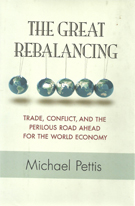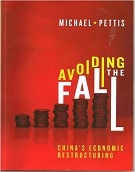It makes sense to review the two books together and not just because they are written by the same author, and within a short period of each other [both were written in 2013]. The more compelling reason for doing so is that they deal with the same phenomenon – the pattern of growth among some high performing economies, based on similar drivers of growth: heavy reliance on investment and exports. The first book has an exclusive focus on China and how these drivers have created the miracle, but which has now exhausted its potential, and must change. The second extends the same analysis to the global scale, and also covers the problems now facing the European Union, and Germany, which, according to Pettis, are similar in kind to the Chinese problems.
 Pettis is an Economics Professor at Peking University, and is a truly global citizen. He has lived in many parts of the world, including Asia, South America, and Europe and got his higher education in the US. In between trading and teaching, he also opened a punk-rock nightclub in Beijing, which is now reported to have closed down.
Pettis is an Economics Professor at Peking University, and is a truly global citizen. He has lived in many parts of the world, including Asia, South America, and Europe and got his higher education in the US. In between trading and teaching, he also opened a punk-rock nightclub in Beijing, which is now reported to have closed down.
The Vivekananda International Foundation was among the early institutions in India to have pointed out that the Chinese economy was facing structural problems, which the high rates of growth should not be allowed to mask. The principal structural problem in China was that the over-investment had created over-capacity, which was being exported in the past – prior to 2008. After that date, those markets were shrinking, and the only alternative was for China to absorb the production internally – by way of higher domestic consumption. However, this was not proving easy of achievement, and this was the main challenge for the Chinese leaders in maintaining even reasonable levels of growth – forget about the “miracle” rates.
The substance of the argument advanced by Pettis is the same: over-reliance by China on investment, especially Government-led investment, had skewed the economy. As he puts it at the very beginning of the book: “...decades of high growth, almost always driven by very high levels of investment, invariably falter(s)”. If this is the case with China and the US [as principal importer] at the global level, the same is true at the European level between the core of Europe, led by Germany, and the periphery of the EU, consisting of all the countries that were so much in the news last year – Spain, Greece, Portugal, etc.
What makes these works especially valuable is that they provide an alternative perspective to the global discourse on growth, and its opposite, under-achievement. Pettis demonstrates that saving and investing are not related to cultural or civilisational attitudes. They are more a function of economic policies, and specifically to interest rates, exchange rates, and wages. He tells us that the Chinese save at such a high rate largely because deposit rates are kept low by the People’s Bank of China; since the Chinese saver needs certain fixed sums for their needs, like for their children’s education, they are forced to save ever larger amounts. In Germany, he makes the telling point that wage growth over the years has been much slower than that in other Eurozone countries.
In this connection, Pettis tells us, in The Great Rebalancing, that several of these Eurozone countries - Spain, Italy, Greece, France – which are now permanently in deficit in the balance of trade, were trade surplus in about an equal number of years as they were in deficit, until the introduction of the Euro as the single currency.
One of the most important points that emerge from both books is the importance of monetary policy. Pettis makes the point that this has been seen mainly in terms of its effect on the consumer price inflation. Since that has remained low, and within the bands prescribed by the various central banks, it has been the case that monetary policy has frequently been too loose. To many of us the obvious answer is that the tax and financial structures have been so altered since Reagonomics that the looser monetary policies have fed into asset bubbles, particularly in stocks and real estate. Pettis, of course, confines himself to the case of China only, and argues that it is not enough to look only at consumer price inflation in judging the effects of monetary policy; but this specific point is more generally true, and 2008 proves the validity of this proposition quite adequately.
These books are also useful in that they provide a non-polemical look at the nature of the global economy, without heroes and villains. He repeatedly makes the point that there is no country that is culturally committed to thriftiness and hard work – or the opposite. It is all a function of policies and incentives. And he does this by looking at the world as one economic unit, where, for instance, a savings glut in one place must be met by very low savings elsewhere to balance the economy. In passing, Pettis uses this argument to justify former Federal Reserve Chairman Bernanke’s observations about a global savings glut, even though the Chinese did not like it. China is indeed saving too much and consuming too little – though Bernanke was careful not to name any country.
All of this analysis leads to the ultimate conclusion that the books offer to the reader. This simply stated is that such policies – of repressing consumption, over-investing and exporting the surplus production – are successful only as long as there are some external entities that will buy the surplus production, and that debt levels are such that investment can continue at a rate that allows at least the servicing of such debt. It is the unambiguous conclusion of Avoiding the Fall that neither is possible any longer for China. The rest of the world is no longer in a position to keep importing from China at pre-crisis levels. That closes one window. Debt has already reached unsustainable levels in China [it was 213% of GDP at the end of February 2014 – not much less than Japan’s] and so investment can also no longer take up the slack.
China must therefore balance the economy on a sustainable basis, by raising consumption, and accepting lower GDP growth rates. Pettis recognises – as we all do – that this is what the stated Chinese policy is, and has been since at least 2005. The trouble is, it does not seem to be happening. According to Pettis, the rebalance is now unavoidable, and the Chinese leaders can either do it in a managed way, or else a hard landing is inevitable. Much the same applies to Germany as well, and it is clear that Pettis is no admirer of the Euro, because it blocks the normal way of adjusting to a sustained balance of payments problem. His prescription: either Germany must change and raise its own consumption levels so that there is greater balance between central and peripheral Europe, or be prepared for a collapse of the Euro.
There is one problem with the analysis put forward in these books: if it is all a matter of policy and incentives, how does one explain intra-country differences? We do not need to look at China alone, but there are more telling examples in Italy and Belgium. North Italy is significantly richer than the South, and the Flemish areas are richer than the Walloon. Obviously, there is more at work here than just interest and wage rates – and it is to do with the historical patterns of industrialisation and economic growth more generally. It would have been interesting to see what Pettis makes of this issue, and it would have rounded out the arguments that he so effectively – and accurately – makes.
One other question begs to be answered: given that one country, in this case China, is following a policy of repressing consumption, and relying on exports to take care of over-capacity, why do other countries follow accommodating policies? Why, in this case, did the US and the EU – until the financial crash – follow policies of over-consumption? This is a valid question, and is an integral part of the analytical framework advanced by Pettis. Both the books are silent on this aspect. In the Eurozone, that would be understandable – there is the political consensus of the Euro, and national policies must bend to the demands of that. But in the case of the US, and the EU vis-a-vis China, there is no such compulsion. Then why did they follow the accommodating policies until 2008 made it impossible to do so any longer?
One wishes Pettis had attempted to address this question, because, in some measure, the need to follow accommodating policies itself caused the financial crash. And here one comes to the last point: Pettis himself mentions that this same model of growth through investment and export has been done by many others, and has almost always ended badly. The question is, why has there been no effort to address this basic imbalance in the trading system? At the time that the US was facing its first balance of payments problems in the late 1960’s and early 1970’s, their internal documents show that they did focus on the need for surplus countries to do as much as deficit countries to fix the imbalance. But in their subsequent actions and policy formulations, they abandoned all this. As a result, we are still working with the presumption that surpluses are good and deficits are bad. But they are in reality just mirror images of each other – every surplus must be matched by a deficit. This remains a problem in the trading system, and will always be a destabilising factor.
That said, these are two useful and well-written books. They are helpful to anyone seeking a true understanding of the great issues being debated in India and the world. Anyone who wishes to understand where the global economy is headed, and particularly whether China is heading for a hard landing, or the Euro will survive – such a person will find very useful analytical guidance in these books.











Post new comment